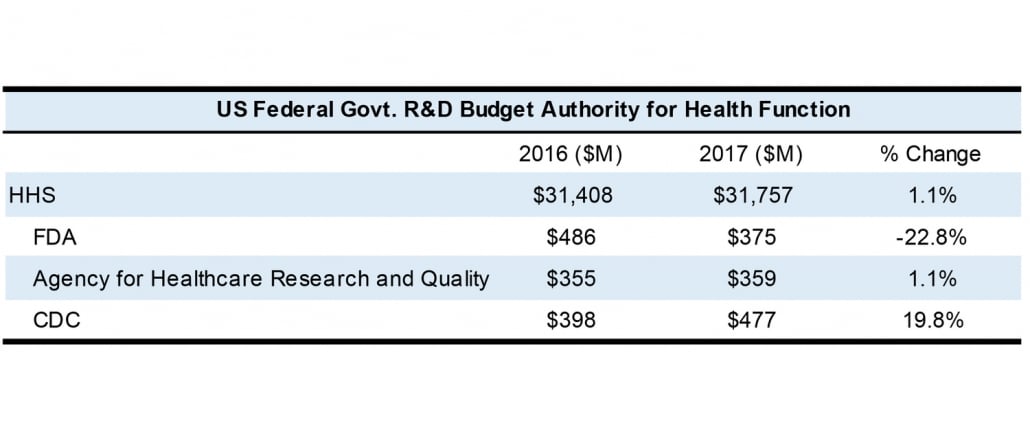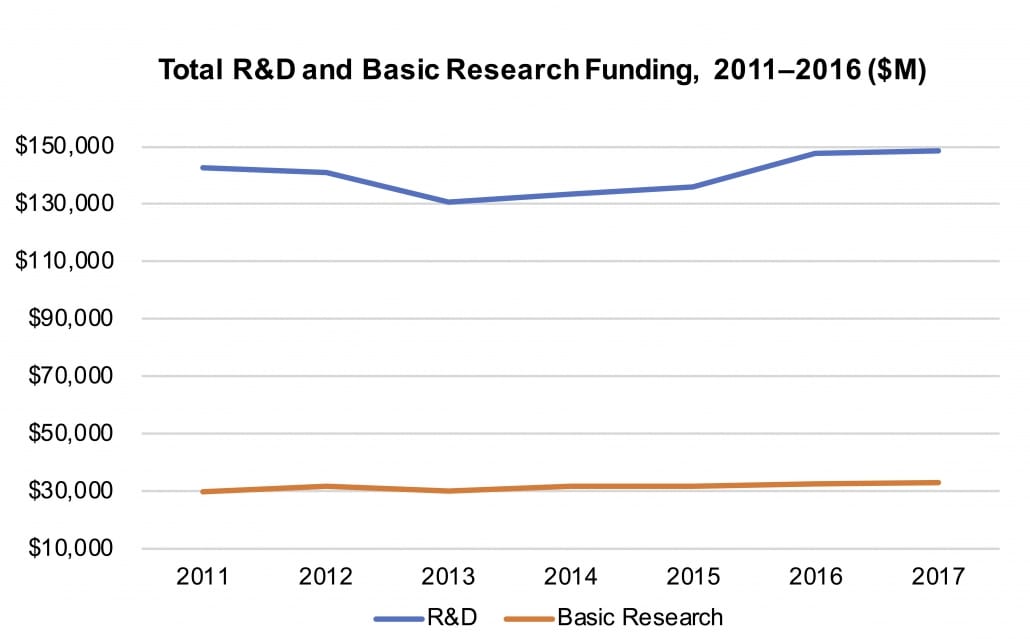Federal Funding Remains Steady Despite Political Uncertainties
Late last month, the NSF released its report on federal R&D funding by budget function, for the fiscal year period of 2016—2018. Although FY 2017 figures are preliminary, the statistics paint a hopeful picture of sustained government R&D funding, despite political discussions regarding major cuts and reformations to government agencies. Total R&D and R&D plant slightly grew to $151.4 billion in FY 2017, a 0.7% increase. R&D and R&D plant budgets, as well as overall R&D budgets, for selected agencies and budget functions are below.
The NSF report examines R&D and R&D plant. In this article, R&D and R&D plant are discussed separately from R&D proper, and tables show R&D data excluding R&D plant information. NSF definitions are below.
The data in the report were collected between June and September 2017, and are indicative of actual and proposed federal R&D funding for the listed agencies’ between FY 2016 and FY 2018. FY 2018 figures are excluded from this article due to that data being based on the initial proposed FY 2018 budget and not the actual passed FY 2018 budget. According to the report, statistics for FY 2016 are actual budget authority (defined as “the primary source of legal authorization to enter into obligations that will result in outlays”) for R&D. The majority of the FY 2017 statistics are “official estimates” that represent the continuing resolution funding for FY 2017, as opposed to the enacted omnibus funding bill for that year (i.e., the Consolidated Appropriations Act that was signed May 2017). Most government agencies did not prepare R&D estimates for FY 2017 based on the final spending statistics in the omnibus bill.
General Science and Basic Research Function
As per the NSF report, basic research is defined as “experimental or theoretical work undertaken primarily to acquire new knowledge of the underlying foundations of phenomena and observable facts,” and may include broad or general applications, but excludes research directed towards a specific application.
The federal budget authority for the DoE’s Office of Science R&D and R&D plant for the General Science and Basic Research function slightly decreased to $5.3 billion in FY 2017. In contrast, the NSF’s budget authority for the function slightly increased in FY 2017 to $6.1 billion. Although complete FY 2017 data is unavailable, funding for certain areas decreased, including the Major Research Equipment and Facilities item, whose total funding decreased almost 20% to $200 million.
The R&D budget authority for the DoE’s Office of Science for the General Science and Basic Research function slightly increased to $4.5 billion in FY 2017, as did the R&D budget authority for the NSF. However, even in regards to R&D budget authority, the Major Research Equipment and Facilities’ budget remained the same at $200 million in FY 2017.
Energy Function
With the Trump administration’s persistent threats to energy funding and certain energy programs last year, the budget authority of the Energy function was uncertain; however, although the Energy function’s budget did decrease, the change was less than 1%, with a $3.5 billion FY 2017 budget authority for the function’s R&D and R&D plant.
The DoE’s budget authority in the Energy function slightly fell to $3.4 billion in FY 2017, while energy programs’ funding also marginally decreased to $3.1 billion. R&D and R&D plant funding for the DoE’s Energy Efficiency and Renewable Energy program and ARPA-E remained flat.
The results are similar in regards to overall R&D funding, with DoE and energy programs’ R&D budgets slightly decreasing to $3.4 billion and $3.1 billion, respectively.
R&D and R&D plant budget authority for the EPA under the Energy function remained flat at $513 million in FY 2017. Science and technology R&D and R&D plant within the EPA fell nominally to $493 million. The overall R&D budget authority for the EPA was slightly less, remaining flat at $510 million, while science and technology R&D funding dropped nominally to $490 million.
Agriculture Function
R&D and R&D plant budget authority for the Agriculture function stayed mostly flat at $2.3 billion in FY 2017, with the largest decrease being the department’s funding for the Conservation and Land Management department, which dropped over 13% to $264 million. Agriculture Research Service and the National Institute of Food and Agriculture R&D and R&D plant funding also remained mostly flat at $834 million in FY 2017.
Figures were lower in regards to overall R&D funding for the Agriculture function. The Department of Agriculture’s overall R&D funding was $2.0 billion in FY 2017, with the Agriculture Research Service receiving $1.1 billion. Within Conservation and Land Management, the Department of Agriculture’s overall R&D budget was $255 million in FY 2017. The National Institute of Food and Agriculture’s R&D budget was the same at $834 million.
Health Function
The FDA’s R&D and R&D plant budget dropped almost 20% to $410 million in FY 2017. As a whole, however, the HHS R&D and R&D plant budget increased marginally to $32.0 billion in FY 2017. Within the HHS, agencies mostly received increases in R&D and R&D plant budgets, with the Agency for Healthcare Research and Quality and the CDC’s budgets totaling $359 million and $477 million, respectively, in FY 2017.
While figures are similar for Health function agencies’ overall R&D budgets, the greatest difference was in the FDA’s R&D budget, which dropped even more than its R&D and R&D plant budget, over 20%, to $375 million. The HHS’s overall R&D budget increased marginally to $31.8 billion. Budgets for the CDC and Agency for Healthcare Research and Quality remained the same as their respective R&D and R&D plant budgets.
NIH Function
Many institutes within the NIH received marginal increases in FY 2017, with the NIH’s total R&D and R&D plant budget increasing slightly to $31.0 billion. The largest budget increase was for the National Cancer Institute (NCI), which grew to $5.5 billion. R&D and R&D plant budgets for the National Institute of General Medical Sciences and the National Institute of Environmental Health Sciences slightly decreased to $1.5 billion and $749 million; in contrast, the National Human Genome Research Institute and National Institute of Biomedical Imaging and Bioengineering’s R&D and R&D plant budgets increased to $508 million and $311 million, respectively.
Budget results are similar for overall NIH R&D funding. The NIH’s overall R&D budget increased nominally to $30.8 billion, while the NCI’s R&D budget grew to $5.4 billion. R&D budgets for the National Institute of General Medical Sciences, the National Institute of Environmental Health Sciences, the National Human Genome Research Institute and National Institute of Biomedical Imaging and Bioengineering’s overall R&D budgets remained the same as their respective R&D plant budgets. The NSF report notes that the NIH budget was increased by approximately 6% in the FY 2017 omnibus, although the growth is not reflected in the data provided.
Trends
Federal funding for R&D, R&D plant and basic research has been a bit of a rollercoaster ride over the years, with funding steadily growing and peaking in 2010 at $149.0 billion (excluding the American Recovery and Restoration Act funding in 2009). After 2010, government R&D funding began its subtle decline, dropping to $136.2 billion in 2014.
However, since 2014, federal R&D funding has actually been increasing, albeit marginally. In FY 2015, federal R&D funding for all budget functions grew 1.8% to $138.6 billion and jumped a further 9.0% in 2016. According to preliminary FY 2017 data, federal R&D funding grew another 0.6% to reach $151.4 billion.
General science and basic research funding took a slight hit in 2013, falling 8.7% to $9.6 billion; however, it recovered in 2014, jumping 9.4% and has been marginally increasing since then. Energy R&D funding has also been steadily growing. Agriculture funding was generally more uncertain, hovering between $1.8 billion and $2.1 billion for the greater part of the 2000s; however, since 2014, Agriculture funding has been steadier and increased to its highest levels since 2000 in 2016, when it reached $2.4 billion.










